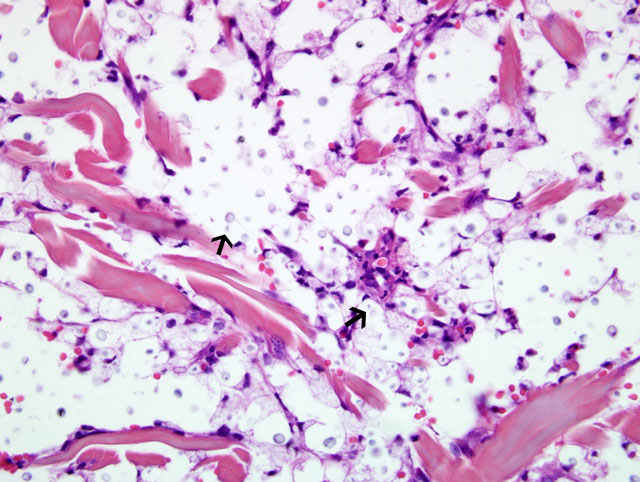Signalment:
Canine, 2-year-old, female, Husky-cross,
Canis lupus familiarisA biopsy from the ear was submitted.
Histopathologic Description:
A section of haired skin from the ear was submitted in which there is
diffuse (and in other regions not included, multinodular foci of dense yeast-like organisms that extended
from the superficial dermis to the deep dermis underlying a multifocally ulcerated epidermis with
multifocal acanthosis and intraepidermal separation (just above the basal layer). There was associated
neutrophilic inflammation and scattered foamy macrophages. Organisms were round to oval (3-20
microns) and refractile surrounded by a clear capsule (up to 40 microns). Some structures exhibit narrowbased
budding (
Fig. 4-1).
Morphologic Diagnosis:
Dermatitis, multifocal ulcerative with intradermal yeast-like
fungi (
Cryptococcus neoformans); cutaneous cryptococcosis
Condition:
Cryptococcus neoformans
Contributor Comment:
Cutaneous cryptococcosis is apparently rare in dogs and more common in
cats.(2) The organism is a ubiquitous saprophyte that is common in nitrogen-rich, alkaline soil and
particularly associated with pigeon excrement. The disease is seen most frequently in humid climates and
is unusual in climates such as Wyoming. Inhalation of airborne organisms is frequently followed by local
upper respiratory tract infection and cutaneous infection is thought to be local extension. Concurrent
immunosuppressive conditions such as diabetes and neoplasia may predispose to infection but this
association is still inconclusive.(3) Rare reports of cryptococcosis in dogs include infection of the central
nervous system and rare cutaneous infection results from disseminated systemic disease.
JPC Diagnosis:
Dermatitis and panniculitis, pyogranulomatous, diffuse, severe with numerous yeast,
etiology consistent with
Cryptococcus neoformans
Conference Comment:
Cryptococcus neoformans (C. neoformans ssp.Â
neoformans) is the most common
systemic fungal infection in cats. The respiratory system is primarily infected; with hematogenous spread
to other organs, most commonly the central nervous systems, skin and eyes. Cryptococcal mastitis in cows
is an ascending, rather than hematogenous, infection.Â
Cryptococcus sp. is the only pathogenic fungus with
a capsule. The capsule causes the gross lesions to appear gelatinous and the histological lesions to have a
soap bubble appearance.(1) Mucicarmine stains the capsule.
The major virulence factors of
Cryptococcus are the capsule and the production of antioxidants such as
melanin. The capsule impairs phagocytosis, activates complement, and possibly suppresses T
lymphocytes. The rare acapsular strains of
Cryptococcus sp. incite abundant granulomatous inflammation
and are readily phagocytized, making them much less pathogenic than the capsular strains. The acapsular
strains of
Cryptococcus neoformans resemble
Blastomyces dermatitidis but can be distinguished by the
presence of narrow-based budding in the former and broad-based budding in Blastomyces dermatitidis.
Some strains are able to produce antioxidants such as melanin and phenoloxidase (laccase), which protect
the organism from oxidative damage by leukocytes.(1)
Cryptococcus gattii (previously C. neoformans ssp. gattii) is primarily found in tropical and subtropical
climates. It is associated with eucalyptus trees and infections in koalas. However, it has recently been
reported in the temperate Pacific Northwest, primarily in British Columbia, where it has infected humans,
dogs, cats, porpoises and ferrets. Unlike Cryptococcus neoformans, it often infects immunocompetent
hosts.(4)
References:
1. Caswell JL, Williams KJ: Respiratory system.Â
In: Pathology of Domestic Animals, ed. Maxie MG, 5th
ed., vol. 2, pp. 642-644. Elsevier, Edinburgh, UK, 2007
2. Gross TL, Ihrke PJ, Walder EJ, Affolter VK: Skin Diseases of the Dog and Cat, pp. 295-297. Blackwell
Science Ltd, Oxford, UK, 2005.
3. Jacobs GJ, Medleau L, Calvert C, Brown J: Cryptococcal infection in cats: factors influencing treatment
outcome, and results of sequential serum antigen titers in 35 cats. J Vet Intern Med
11:1-4, 1997
4. Stephen C, Lester S, Black W, Fyfe M, Raverty S: Multispecies outbreak of cryptococcosis on southern
Vancouver Island, British Coulmbia. Can Vet J
43:792-294, 2002
